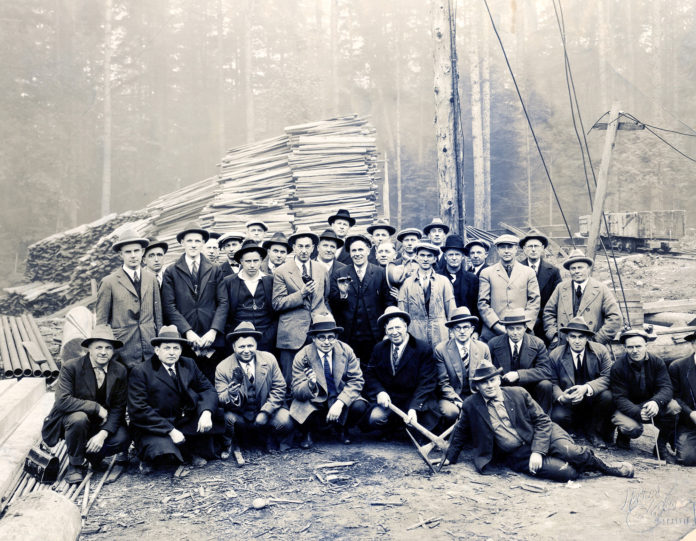By October 1925, Pacific Coast Coal Company’s New Black Diamond mine had just opened, supplanting the company’s Mine #11 in Black Diamond which was nearing its end, having regularly produced an average of 250,000 tons per year. Mine #11 was King County’s most productive coal mine after opening in 1896. But at over 2,000 feet underground, the mine was so deep that excessive pressure made work dangerous for coal miners. So New Black Diamond located at Cedar Mountain on the Renton-Maple Valley Highway took its place.
This photo of mine officials, coal miners, Renton’s mayor, and other dignitaries was taken the same day as that of Tom and Ed Jones, featured in last week’s column. The following individuals are identified: Edward Jones, front row, 1st on left; John Marlowe, front row, 5th from the right; Francis Kane, front row, full man on right; Thomas Jones, stretched out in front; and Mayor George H. Thomas, second row, 3rd from right. The photo was likely taken to commemorate the mine’s completion of a connecting tunnel, as an article about the event appeared in the Oct. 16, 1925, Seattle Daily Times. This photo #1966.999.0749 comes courtesy of the Renton History Museum, with photo details information provided by Liz Stewart, its director.
The Jones family, after whom the Jones Road and Jones Bridge over the Cedar River are named, were Welsh immigrants and early pioneers to the area. The two Jones Brothers, noted above purchased a coal mine called the “Indian” in 1919, which became the western wing of the New Black Diamond mine. A “million-dollar tunnel” connected that opening to the main portal and the extensive surface plant and bunkers to process and ship the coal by rail. Those facilities were located about 200 feet from the Cedar River, separated by the highway that’s now called SR 169. Today the former mine site is a 10-acre grassy field with a couple of power poles and a weather station seen at mile post 20 of Hwy 169. The property is currently owned by Lakeside Industries and is the proposed site for an asphalt plant.
Two months after this photo was taken, tragedy struck the New Black Diamond when Henry Becker and L.W. Foster were killed by a powder explosion in the haulage way. Earlier that year, Frederick Casteel, and F.E. Adams both died in separate accidents after falling from the tipple, a tall structure at the mine’s opening used to pull coal cars up out of the mine. In total, 14 miners died from fatal accidents, including Mike Krbovac (fall of coal), Angelo Banchero (sprain), John Lapan (roof fall), Andrew Postishek (explosives), Otho F. Harte (rock fall), Henry T. Daum (haulage motor), Hugh Murdock (run over by coal car), Walter J. Brennan (electrocuted), Charles W. Barnett (fall of coal), and Charles P. Moroni (struck by coal car).
The New Black Diamond mine operated from 1925 until closing permanently on Aug. 15, 1941, just three months prior to the U.S. entry into World War II. During those 17 years of operation the mine produced 2.4 million tons of coal, employing nearly 300 miners at the height of operations. The 14 fatalities at New Black Diamond yielded a ratio of nearly six deaths per million tons mined. By contrast Mine #11, which New Black Diamond replaced, experienced 65 fatalities for a rate of over nine deaths per million tons mined, albeit during a period with looser safety standards. In Mine #11’s last seven years of operations, when excessive pressure caused deadly bumps, nearly 45% of those 65 fatalities occurred, yielding a far higher death rate.







